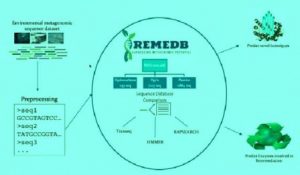Identifying Novel Bioremediation Enzymes: Scientists Devise New Tool
NIOT has successfully developed an innovative bioinformatics tool named RemeDB, which would help identify novel bioremediation-related enzymes.
The global population is continuing to rise at an unprecedented rate with the present estimate suggesting more than 9 billion people in 2050. With the growing needs of this  ever-increasing population, industrialization has become inevitable. But this global industrial revolution has at the same time, contributed to polluting the environment by producing highly toxic chemicals and biological wastes in bulk.
ever-increasing population, industrialization has become inevitable. But this global industrial revolution has at the same time, contributed to polluting the environment by producing highly toxic chemicals and biological wastes in bulk.
In order to devise novel bio-based remediation techniques, the National Institute of Ocean Technology (NIOT) has successfully developed an innovative bioinformatics tool named RemeDB, which would help identify novel bioremediation-related enzymes from a huge set of metagenomic sequence data. RemeDB would thus be helping the scientists to explore novel biomolecules which would lead to eco-friendly remediation measures and increase the prospect of identifyingnovel enzymes which have the potential to degrade environmental pollutants such as hydrocarbon, dye,and plastic.
Bioremediation is a technique to decontaminate the polluted sites, either aquatic or terrestrial, effectively, without generating secondary wastes and involves naturally occurring organisms to break down or neutralize inorganic and organic pollutants into less toxic or nontoxic forms. Thus, the RemeDB software tool would be a boon in prospecting environmental metagenomic datasets which may lead to an eco-friendly conservation effort.
RemeDB developed by NIOT is provided with a huge database of pollutant degrading enzyme (PDEs) withmore than 30,000 enzyme sequences that would help bio- prospect genomes and metagenomes for enzymes that would remediate pollutants such as hydrocarbons, dyes, and plastics. Scientists involved in the project said that the new database would provide scope for identifying novel enzyme sequences, which have the potential to degrade pollutants into non-toxic substances.
According to NIOT scientists, next-generation sequencing technologieshave enabled large scale screening of potential enzymes from environmental samples and RemeDB assists in identifying them with greater precision.
Also Read : Microplastics Threaten Marine Environment along Kanyakumari Coast
Metagenomics is the study of genetic material (total genomic DNA) recovered directly from environmental samples without culturing microbes in the laboratory. Scientists used in silico (computer simulation in reference to biological experiments) approach to develop the RemeDB tool containing a total of 30,925 sequences of PDEs (pollutant degrading enzyme) derived from the Uniprot database, including 14,442 sequences belonging to the major enzyme class of hydrocarbon degradation, 3411 sequences for dye degradation, and 1,308 sequences involved in plastic degradation.
NIOT scientists involved in the development of RemeDB said that it would be a very useful and attractive tool for researchers working on environmental bioprospection and microbial bioremediation.
Led by Dr. Dharani, G. of Marine Biotechnology Division, Ocean Science and Technology for Islands Group, NIOT, Ministry of Earth Sciences, and the research team comprised of Sai H. Sankara Subramanian, Karpaga Raja Sundari Balachandran, and Vijaya Raghavan Rangamaran at NIOT. Their research paper has recently been published in the Journal of Computational Biology.(India Science Wire)
